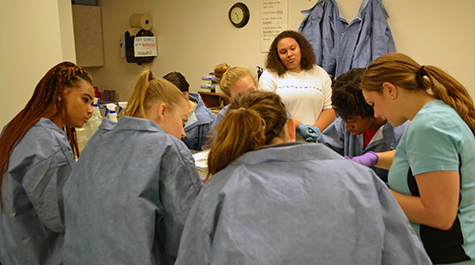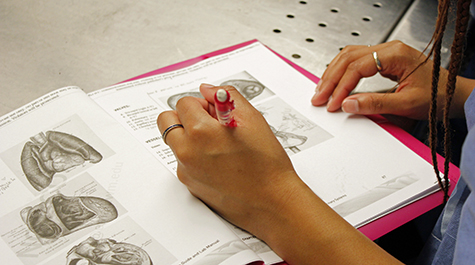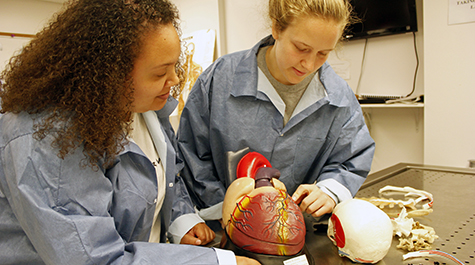Physical Address
Firsthand knowledge: Every year, roughly 160 students at William and Mary take the Anatomy Lab and gain firsthand dissection experience. Photo by Joseph McClain
Cadaver Program
1. Through the Cadaver Outreach Program that offers workshops for a fee to area healthcare professionals or students enrolled in high school, vocational or non-RRCC classes wishing to further their human anatomical education.
2. Through coursework in RRCC’s Physician Assistants Program (PA).
3. Embedded Cadaver Laboratory curricula for students enrolled in select RRCC healthcare or related courses.
Cadaver Outreach Program
The Cadaver Outreach program collaborates with the State Anatomical Board of Colorado to provide hands-on cadaver-based human anatomical training for students enrolled in healthcare or related courses in high school, college and vocational education institutions outside of RRCC.
Workshops last approximately 3-3.5 hours. Students are given the opportunity to hold representative organs for close observation. A trained cadaver instructor conducts question and answer sessions throughout the workshop.
Workshops can be customized for individual programs so that particular organ systems and anatomical features can be emphasized. Workshops can be arranged during the day or evening hours, Monday through Saturday.
Workshops can accommodate 10 to 24 students. Up to two chaperones can attend for no fee. Gloves, goggles, lab coats and a student packet are provided.
To request more information or to schedule a workshop, please click on the email link below:
or call 303-914-6067
Physician Assistant Program (PA)
Students accepted into the PA Program will complete Clinical Anatomy I and II (PAS 609/611 and PAS 610/612) as part of their required coursework. Each course has two complementary components, 1) A cadaver lab component offering hands-on experience of professional prosections and 2) A clinical component emphasizing normal and pathological structure and function supported by extensive medical imaging examples.
Physician assistant students will learn normal human anatomic structure and function, clinically-applied human anatomy, and the anatomic changes seen in pathophysiological processes. The anatomic basis of the physical examination will also be emphasized.
RRCC has the only community college-based PA Master’s degree curriculum in the nation and has been granted continuing accreditation status by the Accreditation Review Commission on Education for the Physician Assistant until March 2027.
“We are proud of our accreditation preparation efforts and how we demonstrated the strength of the Red Rocks PA Program,” said the Director of RRCC’s PA Program Christa Dobbs. “As we near the start of the Master’s degree curriculum in the fall of 2017, we know we have a strong foundation on which to continue to produce excellent PAs.”
To learn more about RRCC’s Physician Assistant Program, please see the program website by clicking on the link below:
Embedded Cadaver Laboratory Curriculum
Students enrolled in select RRCC Healthcare-related courses will be able to enhance their human anatomy foundation by attending hands-on human cadaver labs as part of the lab component of their class work.
Students will be given the opportunity to explore the complex variations of human anatomy and observe up close the effects of disease and age on human structures. Students who choose not to attend the cadaver portion of their lab class will be offered an alternative assignment.
- A-Z Index
- About Us
- Academic Early Alert
- Academic Programs
- Accessibility Services
- Admissions / Apply Now!
- Alumni Relations
- Arvada RRCC Campus
- Assessment
- Behavioral Health Services
- Behavioral Intervention Team (BIT)
- Bookstore
- Campus Maps / Directions
- Career Services
- Collaboration Council
- Contact Us / Directory
- Current Students
- MyCourses (D2L)
- Diversity and Inclusion
- Employment
- Faculty/Staff Outlook Live
- Financial Aid
- Foundation
- Future Students
- Gateway
- Student Health and Counseling
- Honor Society (PTK)
- IT Help Desk
- Industry Training (RMEC)
- International Students / ESL
- Learning Commons
- Library Services
- Mission
- Official Student Complaint Form
- Online Classes
- Portal (The ROCK)
- Register For Classes
- Report a Concern
- Schedule/Catalog
- Scheduling Options
- Scholarships
- Search
- Special Events and Announcements
- Student Jobs
- Student Life/Clubs
- Student Records
- Student Recreation Center
- Student Affairs
- Study Abroad/Academic Travel
- Tell Us How We’re Doing
- Transcripts
- Transfer to 4-Year Colleges
- Tuition And Fees
- Veterans/Military
- Visit Us/Campus Tours
Cadaver lab


Half a century of experience: The Human Anatomy Lab is a class that for over 50 years has allowed undergraduate students to gain an understanding of anatomy using actual human cadavers. This summer, students took notes as instructor Ashleigh Everhardt Queen dissected a heart. Photo by Adrienne Berard

Firsthand knowledge: Every year, roughly 160 students at William and Mary take the Anatomy Lab and gain firsthand dissection experience. Photo by Joseph McClain

Noteworthy: According to the Virginia State Anatomical Program, William and Mary has historically been one of the few undergraduate institutions in Virginia to offer cadaveric dissection and the department is home to one of the oldest programs in the state. Photo by Adrienne Berard
On a recent Tuesday, seven undergrads huddled around a steel dissection table as their lab instructor, Ashleigh Everhardt Queen, discussed matters of the heart.
“Here we go. Coronary vessels, these are the vessels of the heart,” Queen said, probing the human heart with a gloved hand and a scalpel. “The heart is a selfish organ, remember that. It is going to take its blood first. It also does more work than any other muscle in your body, so that makes sense.”
Queen opened the heart to reveal a vast array of structures. For most students, it was the first time they had seen the inner workings of an actual human heart.
Each year, roughly 160 students at William and Mary enroll in the Human Anatomy Lab, a class that for over 50 years has allowed undergraduate students to gain an understanding of anatomy using actual human cadavers.
According to the Virginia State Anatomical Program, the organization that regulates the distribution of cadavers, William and Mary has historically been one of the few undergraduate institutions in Virginia to offer cadaveric dissection and the department is home to one of the oldest programs in the state.
“As a physical therapist, I work with human beings,” said Evie Burnet, lecturer in the Department of Kinesiology, who has taught the lab for 13 years. “I don’t work with cats and I don’t work in virtual reality. Without seeing an actual human body, our students really cannot appreciate the three-dimensional arrangement of its structures. You have to be able to visualize the orientation of muscles and their fibers, organs, nerves and vessels in order to fully understand how it all works together. Nothing else comes anywhere close to doing this for you.”
In an effort to give students more experience with cadavers, each semester the faculty select one or two high-achieving students to mentor their fellow undergraduates in each lab section. “This lab is the reason I decided to go to William and Mary,” says Brooke Ford, the lab’s teaching assistant. “It has one of the only programs where they allow students to dissect, not just view the body, but actually dissect. It’s important for me to know what’s going on in these structures, what’s happening during processes. I need to see it firsthand.”
Two bodies are provided to the lab during the fall and spring semesters. The summer lab dissects only one. During the regular school year, students have the option of actively dissecting during the lab or viewing the dissection. This allows students to feel comfortable being as hands-on or hands-off as they’d like.
At William and Mary, many of the students walk into the lab never having done any dissection before. The course has never been major-locked, meaning that it’s open to anyone with an interest.
“We’ve had art majors who want to understand the human body to better do whichever medium of art they specialize in,” says Burnet. “I had a student in the fall who was a business major. He just thought the class sounded unique and he was an amazing student. I actually asked him if he was sure he wanted to do business, because I thought medicine was his calling. He stayed with business, but that just shows the variety of students who learn from this experience.”










